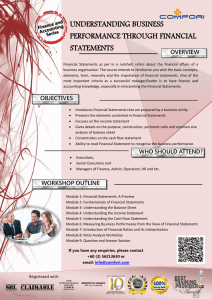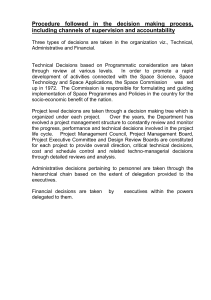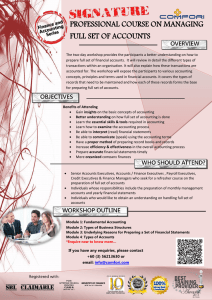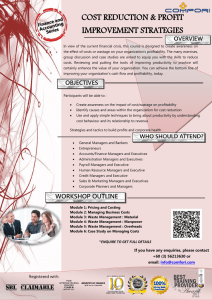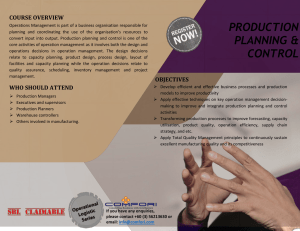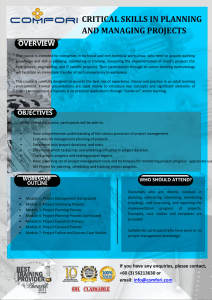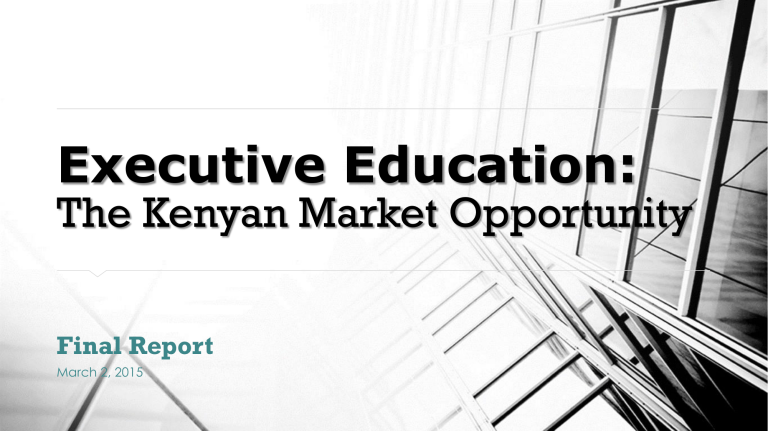
Executive Education: The Kenyan Market Opportunity Final Report March 2, 2015 Table of Contents The future of executive education in Kenya over the next 5-10 years is ripe with opportunity, but in order to deliver and capture value, the current state of collaboration between industry and academia will prove unviable and thus the need for industry players to purposefully shift from doing business as usual. 01 03 05 Introduction & Executive Summary Market Trends and Analysis Customer Analysis 02 04 06 Product Definition Competitive Landscape Conclusions Section 01: Executive Summary The future of executive education in Kenya over the next 5-10 years is ripe with opportunity, but in order to deliver and capture value, the current state of collaboration between industry and academia will prove unviable and thus the need for industry players to purposefully shift from doing business as usual. Overall purpose of the survey The executive education sub-sector is undergoing a fundamental transformation in terms of its role in society, mode of operation, and economic structure and competitive dynamics. The purpose of the Executive Competence Development Survey was to contribute a substantial part of the five-year business plan for Equip Africa Institute. A key element was the evaluation of the overall market potential for the Equip flagship program, the MKU EMBA. To explore these themes and future directions, we have conducted an industry-wide study of the main forces impacting the higher education industry locally, and the opportunities, challenges and implications for Equip Africa institute. We conducted a mix of primary and secondary research, including in depth interviews with business leaders from manufacturing, retail and distribution, consumer electronics, real estate and construction, media, technology, non governmental organizations, service industry, hospitality, professional services, franchising and a good number of entrepreneurs and owner managers. section 01 3 Section 01: Executive Summary Key findings of the survey The Market for Executive Education in Kenya has untapped opportunity arising from the increasing number of growth oriented businesses, ranging from Multi National Corporations to Owner Managed Medium Sized Business, that require skilled management to support their growth efforts. There is a lot of focus in these companies on building their internal capacity based on outlined business strategies thereby creating demand and a pull effect in the market. However, the primary challenge being faced by these companies is the gap between internal needs and external solutions from service providers and the unrealized value for money. This mismatch is due to industry citing that tertiary institutions are providing non-actionable knowledge and further to this, the lack of return on investment measurement means that there is no targeted effort resulting in the unrealized value. The following report is illustrative of the current market trends and consumer analysis in order to highlight areas of opportunity and threats, market dynamics and consumer preferences stemming from both quantitative and qualitative research undertaken. 4 The Allure of Executive Education ‡ Unlocking opportunities ‡ Strategic Importance & Product Definition ‡ Key Demand Drivers Section 02: The Allure of Executive Education Pursuit of training is to unlock opportunities The Kenyan job market has become increasingly competitive over the past few years. This has resulted in a high number of graduates leaving institutions of higher learning and chasing more elusive job opportunities as employment creation has slowed down. The resulting effect is pushing those who have secured employment and job seekers to look for ways of remaining competitive and relevant . The demand has seen thousands of working individuals flocking back to school to improve their skills and acquire additional knowledge with the Masters of Business Administration and Executive Masters of Business Administration emerging as one of the sought after academic courses in the country. Also, owing to the increasing competitive and challenging business environment, there is a growing number of Kenyan Executives trooping back to the class for executive degrees and post graduate certifications. They are driven by the need to keep updated on emerging leadership and management trends as well as to attain self-actualization. Source: IPSOS Synovate 6 Section 02: The Allure of Executive Education The strategic importance of Executive Education Currently in the Kenyan market Executive education has twofold importance. Organizational Importance Organizations and institutions undertake executive training in order to bridge the competency gaps between where they are today and the organization’s strategic intention over the next 1-3-5 year period. Whereby Executive competence development is specifically geared towards building leadership, implementation and management capacity of the organization informed by the corporate strategy. Individual Importance Executives have individual development plans based on their company employee development programs and the same executives are also linked to various professional associations that require continued professional education be undertaken. Therefore the continual fulfilment of these requirements is key in order to build their leadership and managerial competency and make career and professional advancements. 7 Section 02: The Allure of Executive Education How customers view Executive Education Executive education is important to nurture top and emerging leadership. It is important part in any organisation as technology business environments and customer tastes and preferences keep on changing. Our research and industry discussions highlighted a number of major forces impacting the sub-sector in Kenya and these forces coalesced around five key drivers of demand as highlighted below; Organizations desire programs to focus on specialized executive level management to enhance skills and gives them the a new perspective on their roles. Organizational Growth Strategy In an increasingly complex business environment, leaders will continue to look for ways to stay ahead of the crowd and effectuate meaningful change, ensuring continued need for high-quality executive education. Job Market Competitiveness Organizational Succession Planning Individual Career Development De Facto Management Standard Organizations want programs that understand them in terms of what their needs and strategic objectives are and also the time and cost constraints that maybe arise. These programs should therefore be structured in a way that this factors are taken into consideration. 8 Section 02: The Allure of Executive Education Organizational Business Strategy Key demand drivers Organizations are aligning their Job Market internal capacity and competence development with their organizational Competitiveness strategies 0 Organizational Succession Planning In some organizations where there exists strong succession structures, executive training and coaching are key to developing the competencies of the ‘successors’ 0 0 O De Facto Management Standard The Masters degree, is the de facto standard for all executives and because of increased market sophistication more specialization is required both technical and managerial and thus the push to further develop the executive suite. Increasingly competitive job market with elusive job opportunities is the need for further development of executives Individual Career Development Increasingly organizations are requiring their employees to have Individual Development Plans based on employee career plans and identified competence gaps for development. 0 9 Section 02: The Allure of Executive Education “Executive education is a must have in any organisation and should be well researched, localized, industry specialized, progressive and practical. It is the capacity development for management to not only fulfil their current roles but also deliver on forward-looking organizational strategies.” Executive education as described and defined by both individual and institutional customers. Market Trends and Analysis Market segmentation Section 03: Market Trends & Analysis 12 Section 03: Market Trends & Analysis 4P’s & Porters 5 Forces ILC PLC New entrants-bandwagon effect Users/sales: Increasing rapidly Power of Buyers-Increasing Costs: Falling rapidly, utilization, scale and experience effects Power of Suppliers-high Competitors: New entrants, innovator may sell out Threat from Substitutes-growing Marketing objective: Build market share by focusing on new customers and creating distinct brand image Rivalry among firms- Intense, as firms seek to continue to grow at the expense of rivals BMC Product: Falling slowly, supply constraints may keep prices high; Structure (modular, fulltime, bullet) Prices: Low demand side risk, but cash flow risks Promotion: Basic, little variety, quality not high, frequent design changes Place: Specialist retailers, dealers who can give advice, exclusivity deals; online, onsite, offsite Risk: Focus on brand and its advantages, loyalty, bundling, affinity. 13 Finance(37%),consulting(34%)and education(23%)continue to be prospective students most sought after industries. 14 Section 03: Market Trends & Analysis MBA is still preferred by most executives. 55% 54% 54% 57% 2009 53% 2010 2011 2012 33% 32% 28% 2013 25% 26% 18% 13% MBA Only MBA & Masters According to an international study done by Graduate Management Admission Council in 2013 full time MBA programs remain the leading program type among prospective MBA students. 18% 14% 20% 52% of prospects who consider an MBA are interested in a full time two year format; 49% are interested in a full time one year format. Master's Only 15 Section 04: Customer Analysis Market segmentation Segmentation of the Customers The Executive training customers are segmented into two main groupings: 1. Individuals - This includes the Executives both local and international as per below; 2. Top managers Senior managers Middle level managers Individuals •Domestic •International Institutions - This includes: Businesses both Corporates and SME’s Government institutions Non-Governmental institutions The segmentation cuts across all sectors. Institutions •Business •Government •Not for Profit 16 Section 04: Customer Analysis Demographic Characterisation of Business Executives in Kenya Gender Femal e 44% Educational Background Marital Status Male 56% 60% Refused To Answer Age 38% 3% Divorced 1% Widowed 2% Married 3% College & Above Secondary & below Refused To Answer 35+ 30% Другой 70% 25-29 44% Single 52% 43% 30-34 26% Source: The Steadman Group | Sample Size: n=200 17 Section 04: Customer Analysis Key analysis of the Institutions as Executive Education customers A number of industry leaders agreed that Executive Education is a key component for their business to achieve the different goals they have set in place in addition to ensuring individual career growth for their executives. They stated that strategic decisions have been made and implemented in order to ensure that continuous competence development is achieved in the organisation. The different decisions are based on: Budget allocation and competence funding; Decision making and responsibility of executing the executive training programs in the organisation; The decision of who, where and frequency to train; Tools used by the organisations for competence development. 18 Section 04: Customer Analysis Budget Allocation and competence funding Large corporates with training departments stated that their organisations allocate a certain budgetary amount on average being between 2% to 10% of their total annual wage bill to training. Medium sized companies allocate a fixed budget to training which is arrived at after an extensive needs analysis of the competencies required by the organisation based on their growth strategy and the individual’s development plan. Industry leaders of small sized companies differed in terms of allocating a budget to training and stated that training of their executives is on a needs basis. Organizations do co-sponsor or give out loans to the executives and also provide other incentives such as time off/ study leaves. The pre-dominant caveat is that employees have to stay on for a period not exceeding one year or payback in full if the course cost was in excess of USD 20,000/Across the board industry leaders stated that their organisations fund executive training however academic papers they either did not fund completely, give loans to the executives or they would co-sponsor the executive requiring the training. 19 Section 04: Customer Analysis The process of executing the training programs within the organisation Decision making and Responsibility of Executing the Executive training programs are separately executed. Training needs assessment Training needs assessment Needs Assessment analysis Program/ training calendar development Individual needs assessment is done with either the by the human resource department according to the job grade of the employee with person they report to in view of current performance and organizational objectives that touch on the function. Needs Assessment analysis Budget development and approval Training is implementation Evaluation of the training The managers compile the executive needs and liaise with the Human resource or training department to give the individual needs analysis report for analysis based on twofold criteria; Individual performance needs Collectively as an executive team in managerial positions which additional skills they require to posses as a team which executive training they will require based on the business strategy. 20 Section 04: Customer Analysis The process of executing the training programs within the organisation Program/ training calendar development Training is implementation The Human resource manager or training manager in case of any gaps liaises with the executives to guide them and finally prepares a training calendar and program that takes into consideration the organizations calendar, similar training needs for bundling and unique requests. Once this is done the person responsible invites both partners and service providers to propose courses and costings to meet the need. This could be the relevant training consultants or universities, or does the training in-house. The training is implemented based on the partner and program selected. Budget development and approval Evaluation of the training Evaluation of the training and monitoring of the executive training based on the practical implementation of what has been learnt by th executive. It is key to note that non of the organizations interviewed has a formal way to measure the Return on Investment from the training done. Approval of the costs or budget has to be done by the CEO and/or the board. 21 Section 04: Customer Analysis 22 Competitive Landscape Conclusion ‡ Industry Outlook ‡ Key points in the future Development & Marketing of Executive Education ‡ Implications for Equip Africa Institute Section 06: Conclusion Industry Outlook 25 Section 06: Conclusion Key points in the future Development & Marketing 26 Section 06: Conclusion Implications for Equip Africa Institute 27 Annex ‡ Bibliography ‡ Methodology ‡ Framework for Data Analysis ‡ Research Team & Contacts Thank You contact information For more info, please contact us at: E: briansingora@gmail.com P: +254-(0)710-846 667 S: bsingora
